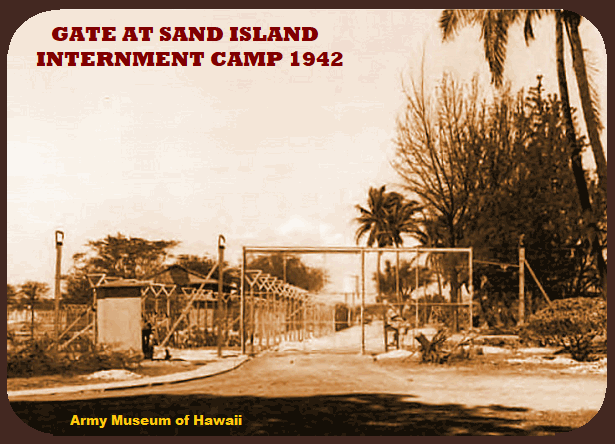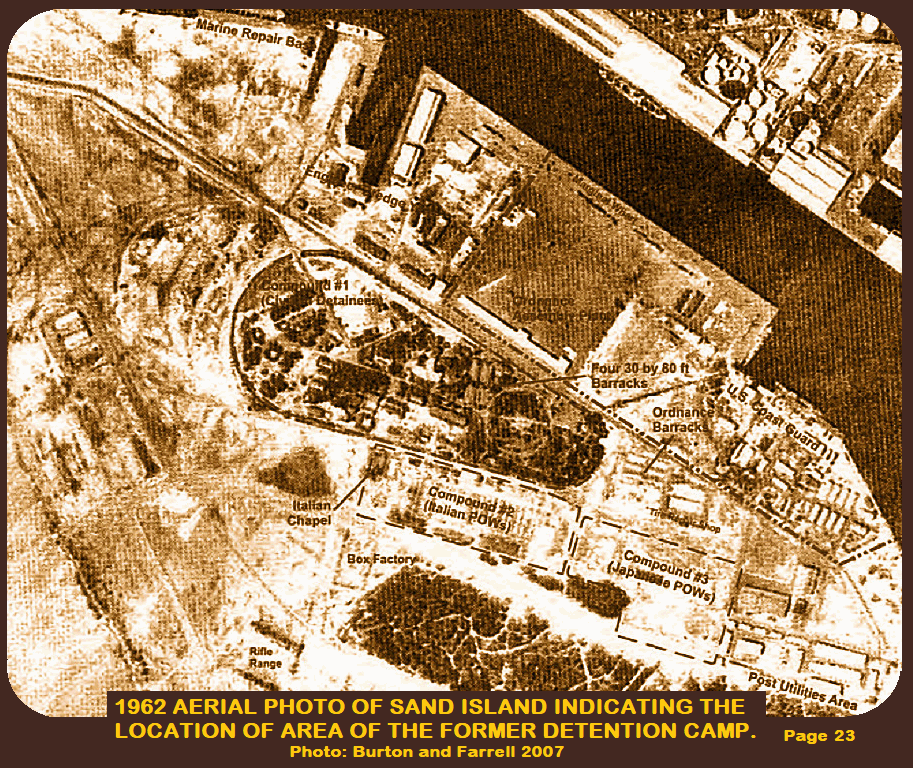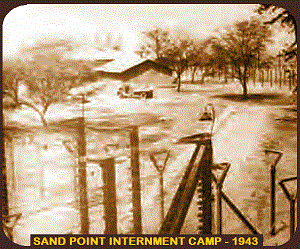SAND ISLAND - OAHU, HAWAII
WORLD WAR II







The Sand Island Internment Camp, outlined in center of the island, served as the principal transfer
and holding site for Hawai'i's civilian detainees for fifteen months after the December 7, 1941 bombing.
and holding site for Hawai'i's civilian detainees for fifteen months after the December 7, 1941 bombing.
The Sand Island camp served as the principal transfer and holding site for Hawai'i's civilian detainees for fifteen months.
However, the island's location in an exposed combat zone put the detainees at risk and generated concerns among officials.
Shipments of Sand Island inmates to the U.S. mainland for prolonged confinement commenced in February 1942 and
continued until the closure of the civilian camp in March 1943. However, the island's location in an exposed combat zone put the detainees at risk and generated concerns among officials.
Shipments of Sand Island inmates to the U.S. mainland for prolonged confinement commenced in February 1942 and
By that point, more than six hundred local residents from across the Hawaiian Islands
had passed through Sand Island on their way to continental camps.
The 149 remaining detainees were taken to a new facility in the Honouliuli gulch in early March 1943.
Two years later, as prisoners arrived from the
European and Pacific theaters,
Sand Island was converted into a POW camp.
By September 1945 the site held
1,010 Koreans and 952 Italians.
Today Sand Island is home to a state recreation area,
a U.S. Coast Guard base, a wastewater treatment facility, and an assortment of industrial facilities,
NO evidence of the wartime detention center remains.
European and Pacific theaters,
Sand Island was converted into a POW camp.
By September 1945 the site held
1,010 Koreans and 952 Italians.
Today Sand Island is home to a state recreation area,
a U.S. Coast Guard base, a wastewater treatment facility, and an assortment of industrial facilities,
NO evidence of the wartime detention center remains.

The information
on the image left
was used to
creat the image
at top of
this page :)
on the image left
was used to
creat the image
at top of
this page :)

The statue is outside the
Coast Guard's
Florence Ebersole Smith
administration building
on Sand Island.
Bruce Asato • The Honolulu Advertiser
Coast Guard's
Florence Ebersole Smith
administration building
on Sand Island.
Bruce Asato • The Honolulu Advertiser
Marinaio Sergio Cadalano
of the Italian tall ship
Amerigo Vespucci
examines
"The Hula Dancer,"
created by Alfredo Giusti,
an Italian POW
who was interned
on Sand Island
during World War II.
of the Italian tall ship
Amerigo Vespucci
examines
"The Hula Dancer,"
created by Alfredo Giusti,
an Italian POW
who was interned
on Sand Island
during World War II.
"IN 2002"
About 25 cadets,
several officers and
15 crew members of the
Naval Academy training
Tall Ship Amerigo Vespucci,
had visited Schofield and
laid a wreath on the graves.
About 25 cadets,
several officers and
15 crew members of the
Naval Academy training
Tall Ship Amerigo Vespucci,
had visited Schofield and
laid a wreath on the graves.
Between 1944 and 1946, 5,000 Italian prisoners of war were held at Schofield, in Kane'ohe, Kalihi Valley and on Sand Island.
They were captured by the British in North Africa in 1943, and
at least one account had them arriving after passing
through Fort Lawton in Seattle.
But evidence of their internment here remains in a more concrete form: statuary designed by Italian POWs that is still on display at
Fort Shafter and at the Coast Guard station on Sand Island.
The former Sand Island Detention Center held war captives
as well as civilians of Japanese, German or Italian ancestry
who were under investigation.
The Italian POWs also were responsible for a statue
at the Immigration Center at Ala Moana,
and Mother Cabrini Chapel at Schofield,
which was later torn down.
They were captured by the British in North Africa in 1943, and
at least one account had them arriving after passing
through Fort Lawton in Seattle.
But evidence of their internment here remains in a more concrete form: statuary designed by Italian POWs that is still on display at
Fort Shafter and at the Coast Guard station on Sand Island.
The former Sand Island Detention Center held war captives
as well as civilians of Japanese, German or Italian ancestry
who were under investigation.
The Italian POWs also were responsible for a statue
at the Immigration Center at Ala Moana,
and Mother Cabrini Chapel at Schofield,
which was later torn down.
CLICK











